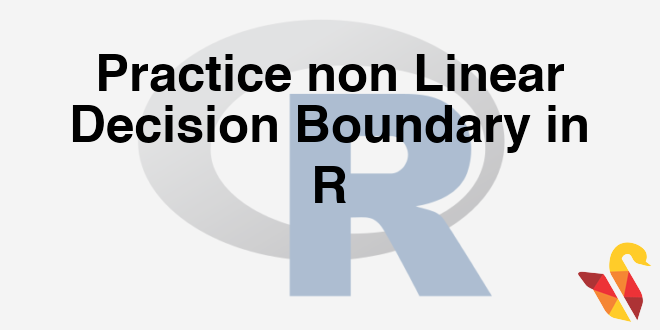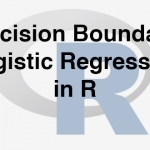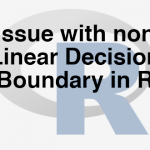
In previous section, we studied about Decision Boundary – Logistic Regression
Linear decision boundaries is not always way to go, as our data can have polynomial boundary too. In this post we will just see what happens if we try to use a linear function to classify a bit complex data.
LAB: Non-Linear Decision Boundaries
- Dataset: “Emp_Productivity/ Emp_Productivity.csv”
- Draw a scatter plot that shows Age on X axis and Experience on Y-axis. Try to distinguish the two classes with colors or shapes (visualizing the classes)
- Build a logistic regression model to predict Productivity using age and experience
- Finally draw the decision boundary for this logistic regression model
- Create the confusion matrix
- Calculate the accuracy and error rates
Here we are considering the entire data not the subset
####The clasification graph on overall data
library(ggplot2)
ggplot(Emp_Productivity_raw)+geom_point(aes(x=Age,y=Experience,color=factor(Productivity),shape=factor(Productivity)),size=5)###Logistic Regerssion model for overall data
Emp_Productivity_logit_overall<-glm(Productivity~Age+Experience,data=Emp_Productivity_raw, family=binomial())
Emp_Productivity_logit_overall##
## Call: glm(formula = Productivity ~ Age + Experience, family = binomial(),
## data = Emp_Productivity_raw)
##
## Coefficients:
## (Intercept) Age Experience
## 0.44784 -0.01755 -0.06324
##
## Degrees of Freedom: 118 Total (i.e. Null); 116 Residual
## Null Deviance: 155.7
## Residual Deviance: 150.5 AIC: 156.5slope2 <- coef(Emp_Productivity_logit_overall)[2]/(-coef(Emp_Productivity_logit_overall)[3])
intercept2 <- coef(Emp_Productivity_logit_overall)[1]/(-coef(Emp_Productivity_logit_overall)[3])
####Drawing the Decision boundary
library(ggplot2)
base<-ggplot(Emp_Productivity_raw)+geom_point(aes(x=Age,y=Experience,color=factor(Productivity),shape=factor(Productivity)),size=5)
base+geom_abline(intercept = intercept2 , slope = slope2, colour = "blue", size = 2) ####Accuracy of the overall model
predicted_values<-round(predict(Emp_Productivity_logit_overall,type="response"),0)
conf_matrix<-table(predicted_values,Emp_Productivity_logit_overall$y)
conf_matrix##
## predicted_values 0 1
## 0 69 43
## 1 7 0accuracy<-(conf_matrix[1,1]+conf_matrix[2,2])/(sum(conf_matrix))
accuracy## [1] 0.5798319- The next post is about Issue with Non-linear Decision Boundary.




